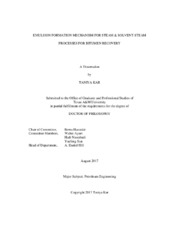| dc.description.abstract | Hydrocarbon solvents are known to improve the overall oil recovery from oil sands when co-injected with steam, compared to steam injection alone in thermal enhanced oil recovery. However, the quality of the recovered oil is crucial in terms of water-oil emulsion complexity, especially due to the presence of significant asphaltene content in bitumen and water from steam processes. In addition, the type, chemical nature, and asphaltene solubility power of the hydrocarbon solvent injected, along with the reservoir clays, can either enhance or destabilize these emulsions. Moreover, crude oil itself has non-polar and polar fractions apart from asphaltenes, which have their own associations with these solvents, water, and reservoir clays. Emulsion formation is an interface phenomenon, and thus, the interactions between individual components in the obtained oil phase must be analyzed to understand it. In this study, steam and solvent-steam flooding, SAGD and Solvent-SAGD experiments were performed, and the obtained oils from these experiments were studied in terms of emulsion characterization, produced oil composition. Several correlations were inferred, depicting the interactions among these components.
Based on experimental results, the addition of either paraffinic or aromatic solvents improves the quality of produced oil, compared to steam injection alone, by lowering the amount of water carried with the oil. Kaolinite clay has a greater affinity towards water-phase compared to oil-phase. Mixtures of kaolinite and illite, on the other hand, interact more with the oil phase, along with water, thereby stabilizing emulsions via deposition at the interface. Lastly, presence of the aromatic solvent, toluene, generally lowers the quality of the obtained oil by increasing the polarity and dispersion of asphaltenes in crude oil, consequently promoting water-oil and clay-oil associations. | en |


